Would you like to know about German Shepherd coat color patterns and variations? You’re in the right place.
In this post, we have covered 10 main coat color patterns and 37 color variations found in German Shepherds.
German Shepherds exhibit a variety of coat color patterns and variations, making them a visually diverse and striking breed. The most common and iconic coat color pattern is black and tan, where the dog has a black saddle across its back and tan or reddish-brown fur on the legs, underbelly, and face.
Other variations include black and red, where the reddish color is more prominent; sable, where individual hairs have multiple colors giving a shaded effect; and solid black, where the entire coat is black. Additionally, German Shepherds can come in rarer colors such as blue, liver, panda, and even white, although all kennel clubs may not always recognize these colors.
Topics
- German Shepherd Coat Color Patterns
- Saddle Coat Color Pattern
- Blanket Coat Color Pattern
- Sable Coat Color Pattern
- Bicolor Coat Color Pattern
- Solid Black Coat Color Pattern
- Solid White Coat Color Pattern
- Solid Liver Coat Color Pattern
- Panda Coat Color Pattern
- Solid Blue Coat Color Pattern
- Solid Isabella Coat Color Pattern
- German Shepherd Coat Color Variations
- 37 Coat Color Variations
- Final Thoughts
RELATED
- How Does Selective Breeding Affect Dog’s Appearance
- How to Measure Height & Length of a German Shepherd
- Top German Shepherd Breeders Around the World
- In What Ways German Shepherds Are Similar to Wolves?
- How to Know German Shepherd Breeder is Genuine?
- Are German Shepherds Descendants of Wolves?
- How Slant (Sloped) Back German Shepherds Were Created?
- How to Identify the Purity of German Shepherd Puppy | 5 Ways
- 5 Different Types Of German Shepherd Breeds & Their Features
- How Do German Shepherds Handle Hot Weather
|| DON’T MISS! Today’s Deals on Chewy – Pet Foods, Products, Supplies, Toys and more…
01. German Shepherd Coat Color Patterns
There are 10 main color patterns of German Shepherds i.e., Saddle, Blanket, Sable, Bicolor, Solid Black, Solid White, Solid Liver, Solid Blue, Solid Isabella, and Panda.
RELATED
- 4 Types of German Shepherd Coats
- 8 Ways to Identify Long Coat German Shepherd Puppy
- Should You Shave a German Shepherd in Summer?
01. Saddle Coat Color Pattern
The German Shepherd’s “saddle” color pattern is called so because the darker coloration on the dog’s back resembles the shape and position of a horse’s saddle. The dark marking (typically black) is centered over the dog’s back and shoulders, similar to how a saddle would rest on a horse’s back.
This pattern is most commonly seen in black and tan, black and red, black and silver, and black and cream German Shepherds, as shown in the “Color Variations Section” below. This iconic pattern is one of the most recognized features of the German Shepherd and contributes to their striking and noble appearance.
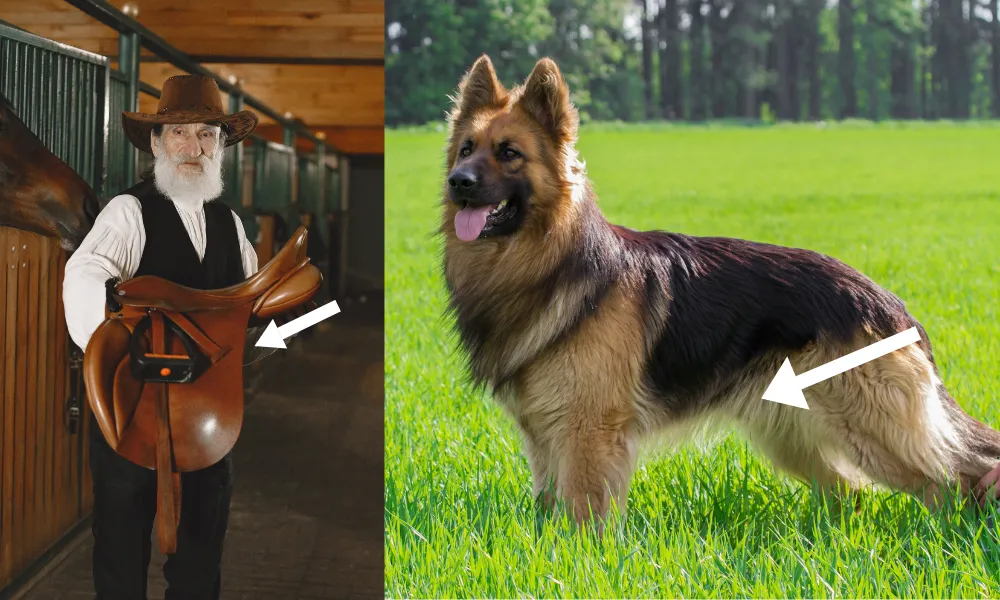
02. Blanket Coat Color Pattern
The Blanket Color Pattern in German Shepherds features a large, dark black marking that covers most of the dog’s back and sides, resembling a “blanket” draped over the body.
Unlike the saddle pattern, where the dark marking is more confined, the blanket pattern extends further down the sides, creating a bolder contrast with the tan, red, or silver base.
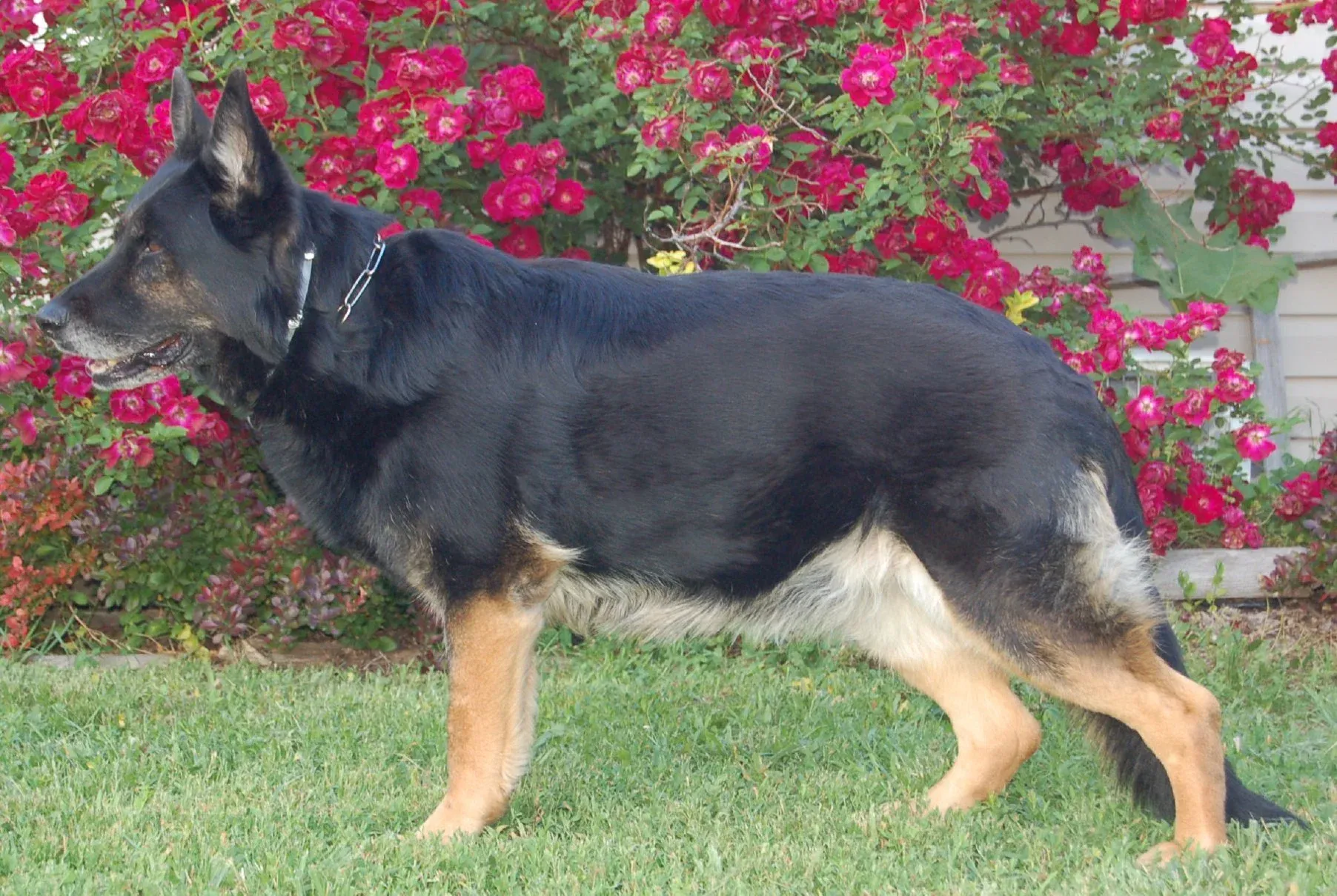
03. Sable Coat Color Pattern
The sable color pattern is characterized by a coat where each hair is banded with multiple colors, typically a mix of black, gray, tan, or red. This creates a dynamic, wolf-like appearance that can change slightly as the dog moves or matures.
The sable color pattern is unique because it is not a solid color but rather a blend that gives the dog a rugged, natural look, often associated with the working lines of the breed.
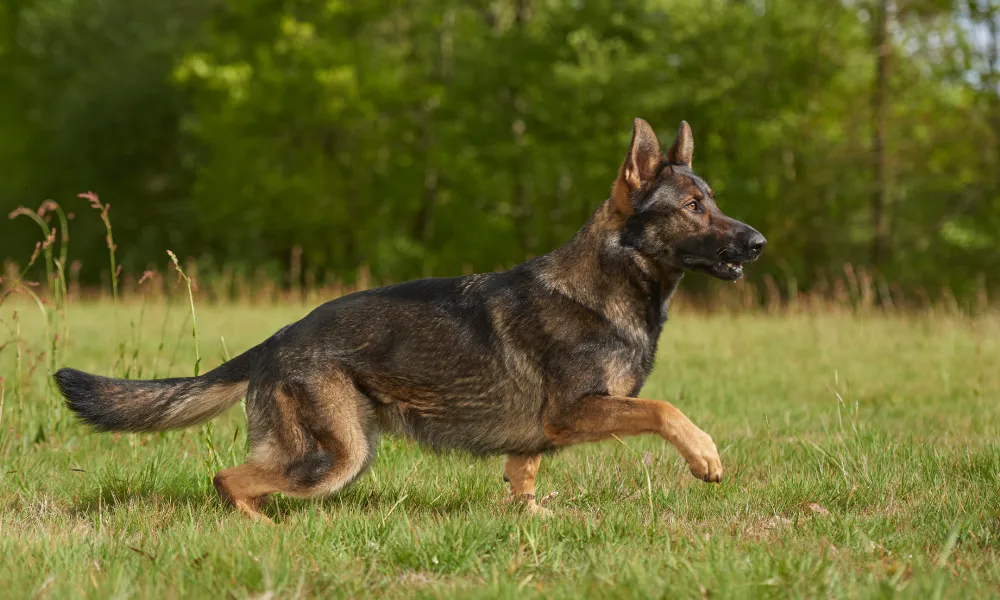
RELATED
- Slant Back German Shepherds | Types of Showline GSDs
- Straight Back German Shepherds | Types of Working Line GSDs
04. Bicolor Coat Color Pattern
The bicolor color pattern is predominantly black with minimal markings of another color, typically tan or rust. These lighter markings are usually limited to specific areas, such as the legs, under the tail, and occasionally around the face or chest.
Unlike the saddle or blanket patterns, the black color dominates in the bicolor pattern, giving the dog a bold and striking appearance.
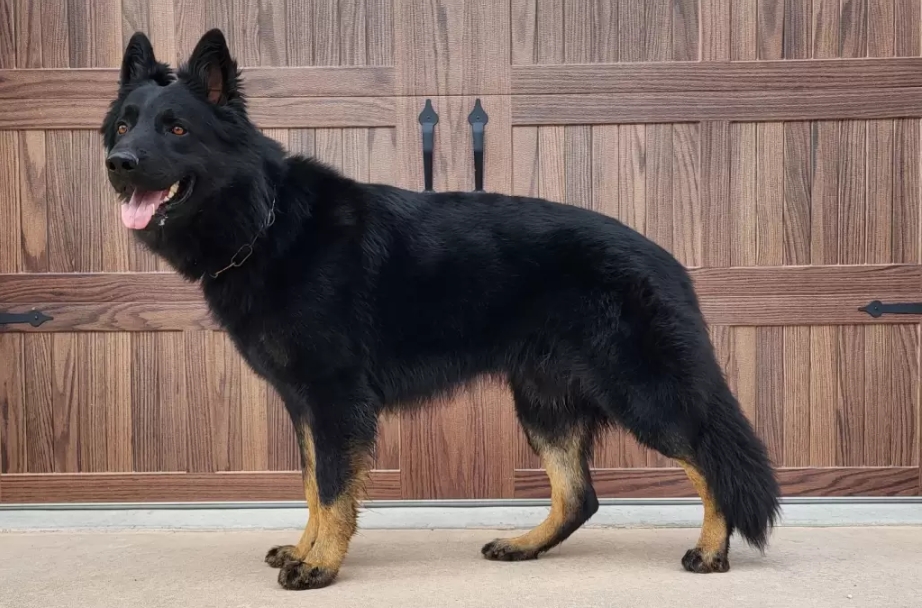
05. Solid Black Coat Color Pattern
The solid black color pattern features an entirely black coat with no markings or contrasting colors. This uniform coloration gives the dog a sleek and striking appearance, emphasizing their muscular build and strong features.
Solid black German Shepherds are often found in both working and show lines, valued for their striking appearance and resemblance to their ancestral wolf-like heritage.
| The solid black color in German Shepherds is the result of a recessive gene. It means that for a German Shepherd to be solid black, both parents must carry the gene for this coloration, even if they do not display it themselves. This genetic trait is purely aesthetic and does not affect the dog’s temperament, health, or abilities. |
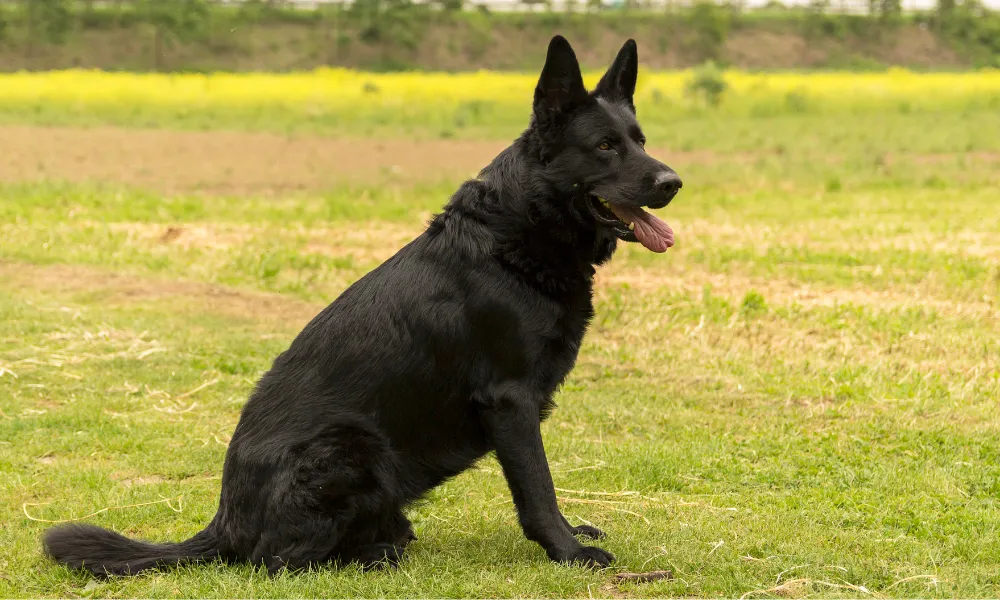
06. Solid White Coat Color Pattern
The white coat color pattern is a rare genetic variation called the “White German Shepherd.” These dogs have a solid white coat, with no markings or other colors.
White German Shepherds are not recognized in some breed standards, but they are loved for their striking appearance and gentle temperament.
| The white color in German Shepherds occurs due to a recessive gene that causes a lack of pigmentation in the coat. Lack of pigmentation means the absence of color in the skin, fur, or eyes, which occurs when the body doesn’t produce enough of the pigments (like melanin) that give color. This results in white or very light-colored features. |
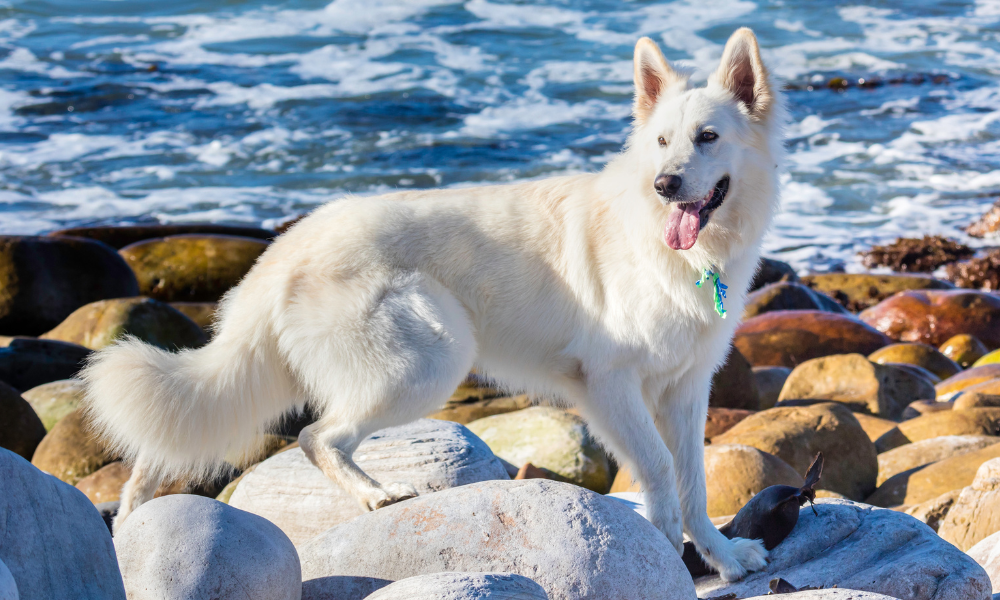
RELATED
- Are White German Shepherds Purebred? | Cause of White Color
- Is White German Shepherd a Good Family Dog?
07. Solid Liver Coat Color Pattern
The Solid Liver Coat Color Pattern is distinguished by its rich, chocolate-brown coat that is uniform in color, with no black pigmentation.
The eyes often complement the coat with shades of amber or light brown, and the nose is usually a matching liver color rather than black.
| The liver color in German Shepherds occurs due to a recessive gene that suppresses black pigmentation (eumelanin), replacing it with a brown (liver) tone. Both parents must carry and pass on this gene for a puppy to display the liver color. |
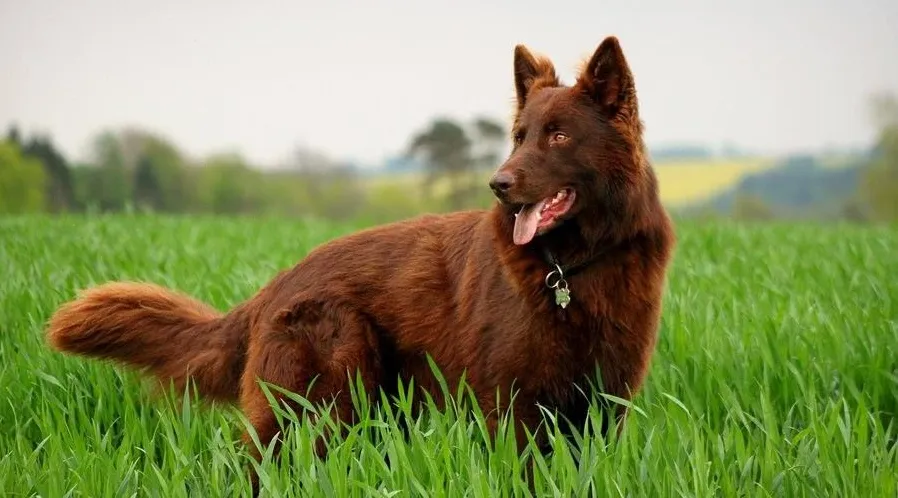
RELATED
08. Panda Coat Color Pattern
The Panda Coat Color Pattern is a rare and eye-catching color pattern characterized by a unique piebald color pattern. This includes a mix of black, tan, and up to 35-40% white markings on the coat, typically on the chest, belly, legs, and face.
| The Panda pattern in German Shepherds is caused by a spontaneous genetic mutation in the KIT gene, which affects pigmentation. This mutation results in the unique piebald (white spotting) pattern. The trait is dominant, so only one parent needs to carry the mutation for it to appear in offspring. |
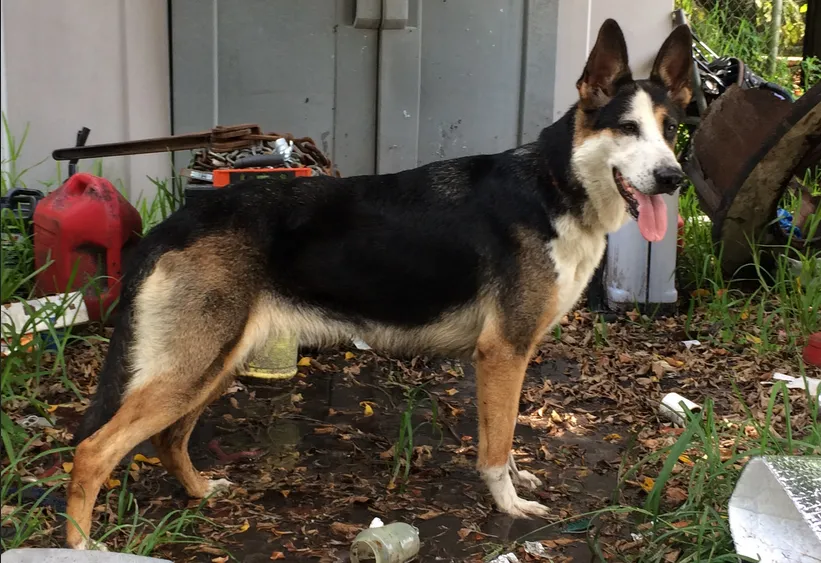
RELATED
09. Solid Blue Coat Color Pattern
The Solid Blue Coat Color Pattern is a rare and stunning variation with an even, steel-blue (medium to dark shade of blue with a gray tint) coat color throughout the body. The nose and paw pads are typically a matching blue-gray, and their eyes are often lighter, ranging from amber to pale yellow.
| The blue color in German Shepherds is caused by a recessive dilution gene (the d allele) that lightens black pigmentation (eumelanin) to a grayish-blue tone. For a dog to display this color, it must inherit the dilution gene from both parents. This genetic change affects the coat, nose, and sometimes eye color, creating a distinctive blue appearance. |
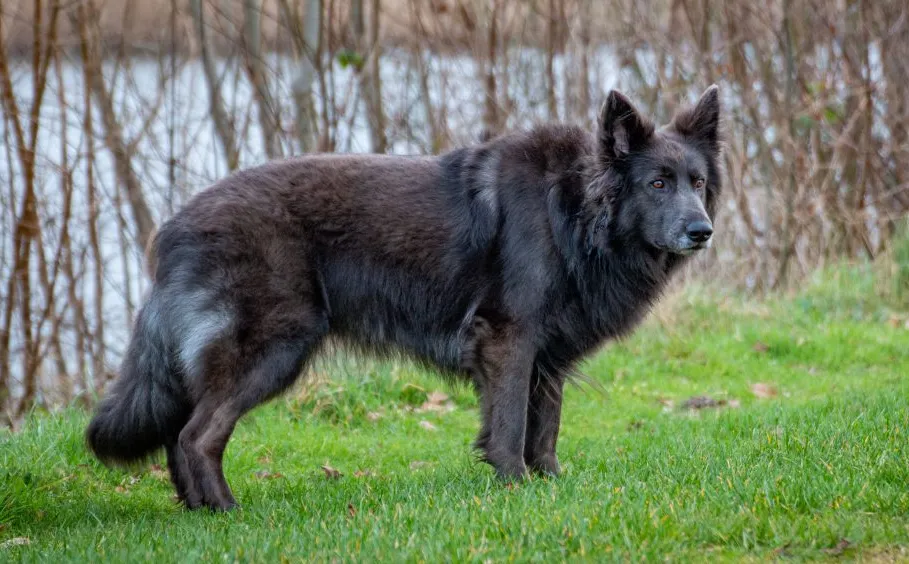
10. Solid Isabella Coat Color Pattern
The Solid Isabella Coat Color Pattern is a captivating rare color variation distinguished by its delicate and unique coat. This features a fully solid, light tan, or fawn color without much contrast or darker markings. The coat can appear more uniform and soft in appearance.
| The Isabella color in German Shepherds arises from the combined effect of dilution genes, transforming black and red pigments into a soft, silvery-fawn or lilac hue. |
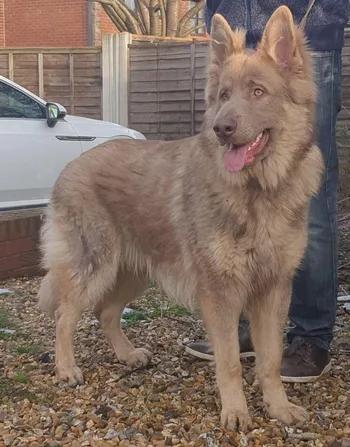
02. German Shepherd Coat Color Variations
German Shepherds come in an array of shades that add to their individuality and charm. Each coat color variation has its appeal and sometimes even unique genetic background, making the breed even more fascinating.
01. Black and Tan Saddle
The black and tan saddle coloration is the most iconic and widely recognized pattern in German Shepherds. This variation features a rich tan base coat with striking black markings forming a “saddle” over the dog’s back and a black mask on the face.
The tan areas typically cover the legs, chest, and lower body, creating a stunning contrast with the dark overlay.
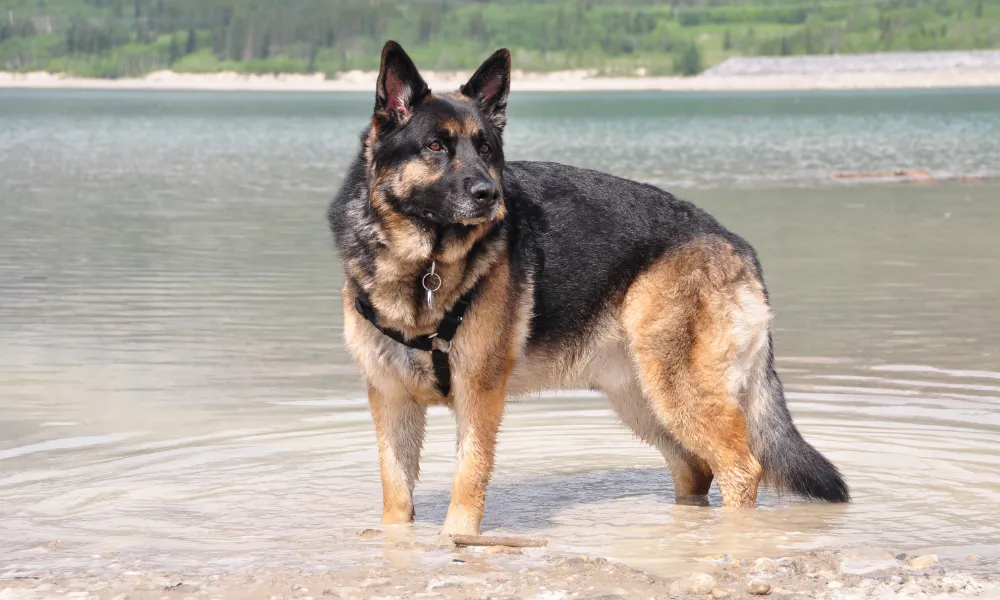
02. Black and Red Saddle
The black and red color variation is a striking and elegant look often associated with show-line German Shepherds. In this variation, the coat features a deep, rich red base color complemented by bold black markings that form a “saddle” pattern and a distinctive black mask.
The red areas are typically more vibrant and pronounced than the tan seen in other variations, adding to the dog’s regal and refined appearance. This coloration is highly prized for its beauty and is commonly seen in German Shepherds bred for conformation shows.
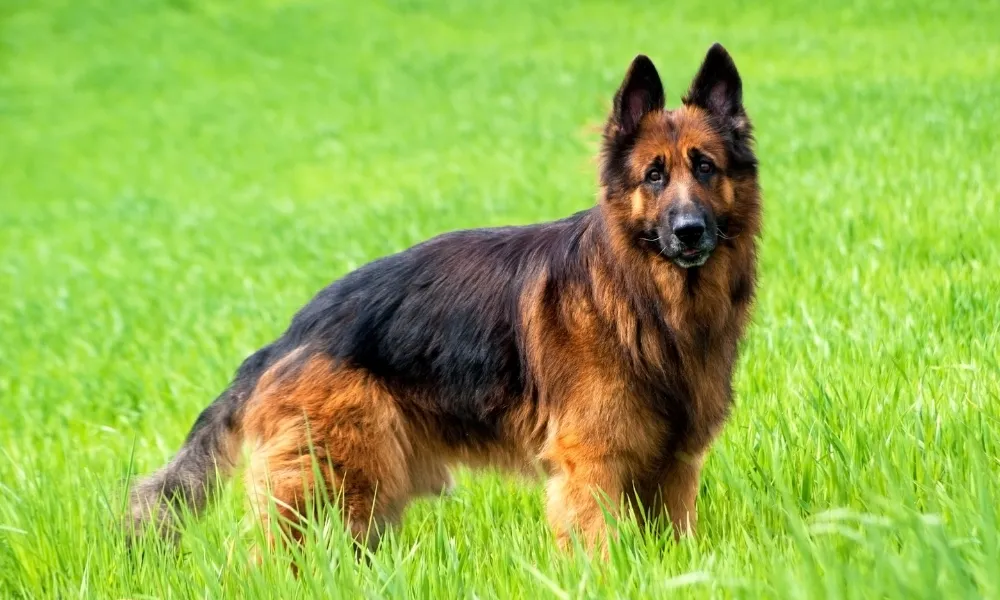
03. Black and Cream Saddle
The black and cream saddle color variation in German Shepherds is a softer, more subdued version of the classic saddle pattern. It features a cream or light beige base coat, contrasted by bold black markings forming a “saddle” on the back and a black mask on the face.
The cream areas typically cover the legs, chest, and lower body, creating a gentle yet eye-catching appearance. This variation is less common than the black and tan but is equally beautiful, giving the dog a unique and elegant look.
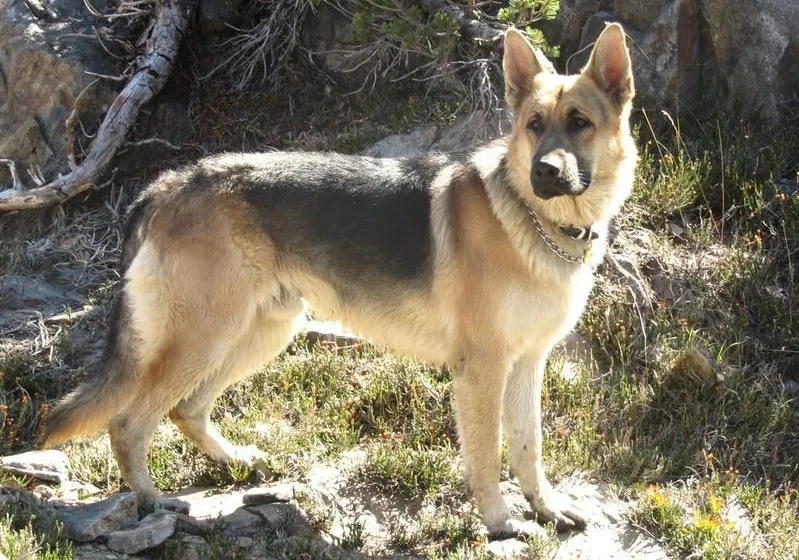
04. Black and Silver Saddle
The black and silver saddle color variation is a striking and rare pattern in German Shepherds. It features a light silver or grayish base coat contrasted with bold black saddle markings and a black facial mask.
The silver areas often appear on the legs, chest, and underside, creating a sharp and dramatic contrast that highlights the breed’s strong and graceful build.
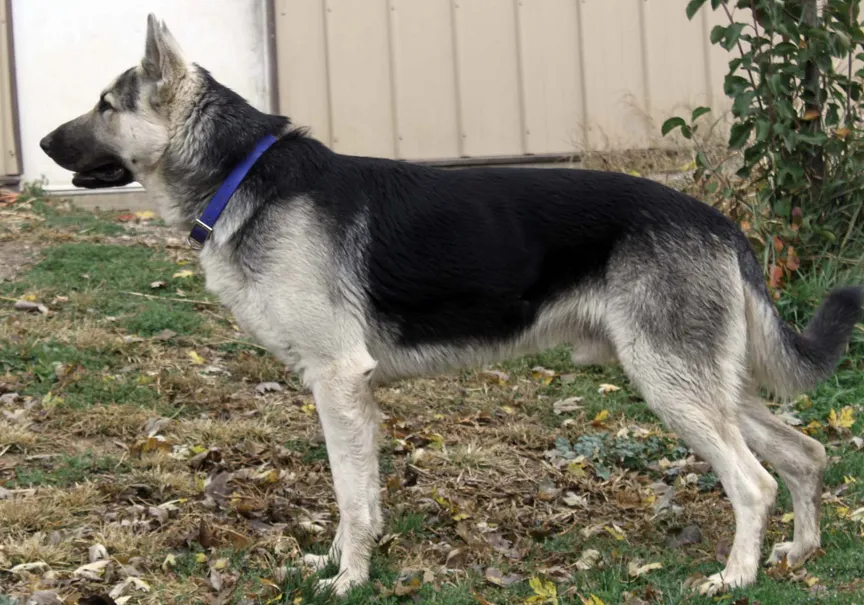
05. Black and Tan Blanket
The black and tan blanket color variation is a distinctive color variation where the black markings extend beyond the classic “saddle,” covering most of the dog’s back like a blanket.
This creates a contrast with the tan areas, which typically appear on the legs, chest, face, and underside. The black blanket gives the dog a bolder and more robust appearance, while the tan highlights maintain the breed’s traditional and recognizable look.
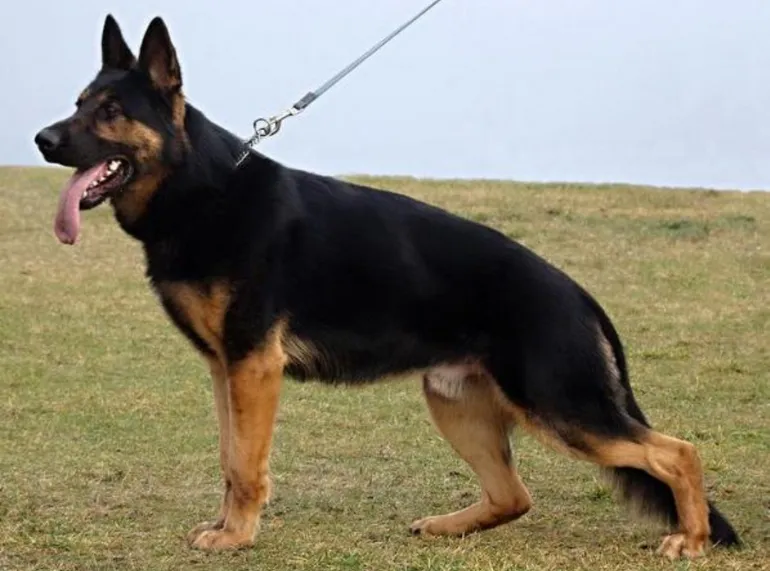
06. Black and Red Blanket
The black and red blanket color variation is a stunning and bold pattern where a deep, rich black “blanket” covers most of the dog’s back, extending more extensively than the classic saddle pattern.
The vibrant red base coat appears on the legs, chest, face, and underside, creating a striking contrast with the dark blanket overlay.
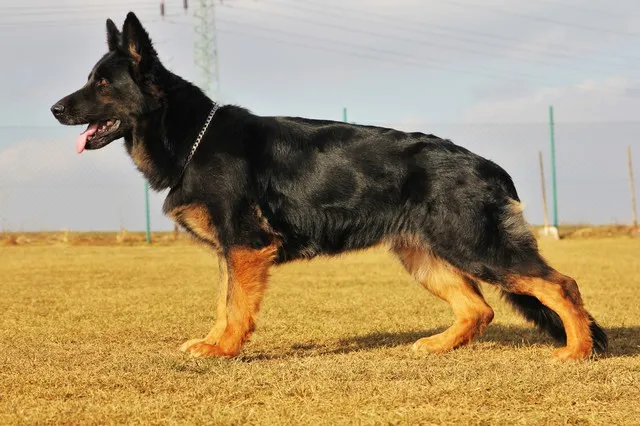
07. Black and Silver Blanket
The black and silver blanket color variation is an eye-catching pattern where a prominent black “blanket” covers much of the dog’s back, shoulders, and sides.
The silver base coat appears on the legs, chest, face, and underside, offering a striking contrast to the dark overlay.
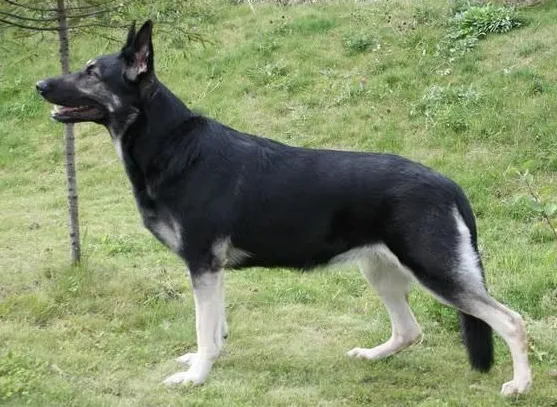
08. Black and Tan Bicolor
The black and tan bicolor variation is a striking pattern characterized by a predominantly black coat with subtle tan markings.
The tan is usually limited to small areas on the legs, chest, and sometimes the face, creating a bold and powerful appearance.
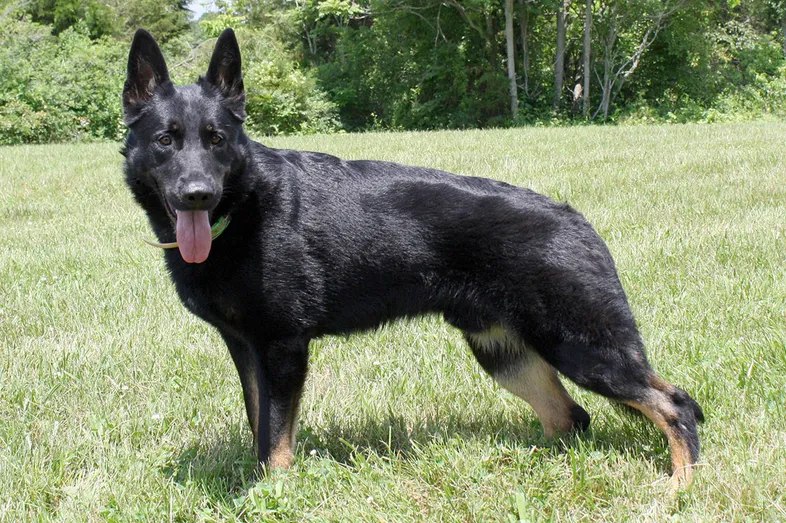
09. Brown Sable
The brown sable color variation is a dynamic and richly textured coat pattern. This variation features a mix of brown tones, ranging from light tan to deep mahogany, with dark-tipped hairs that give the coat a “sable” effect.
The overall appearance is earthy and natural, with no distinct saddle or blanket markings, as the colors blend seamlessly across the body.
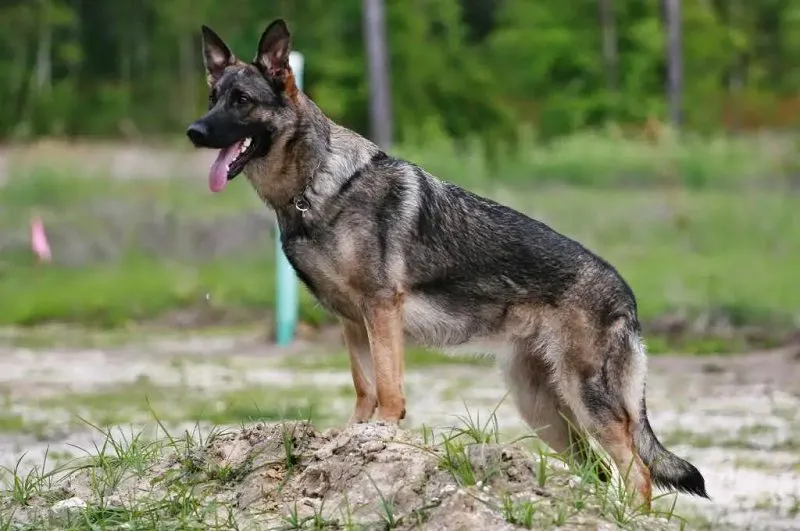
10. Red Sable
The red sable color variation is a vibrant and striking coat pattern that showcases a mix of rich red tones with dark-tipped hairs, creating the signature “sable” effect.
Unlike defined patterns like saddles or blankets, the colors blend seamlessly across the coat, giving the dog a wild, natural, and dynamic appearance.
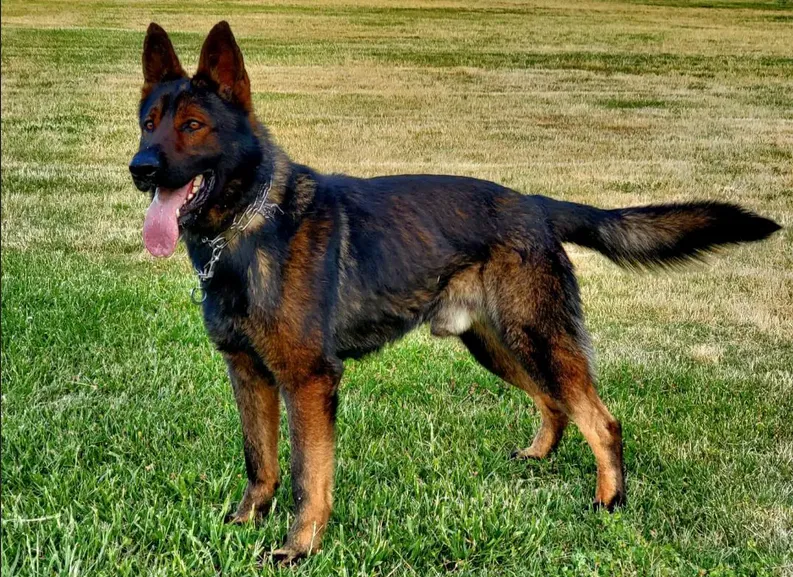
11. Black Mahogany Sable (melanistic)
The Black Mahogany Sable (melanistic) color variation is a dark pattern. This variation features a deep mahogany red or brown base coat interwoven with heavily dark-tipped hairs, creating a dramatic “sable” effect.
The melanistic shading intensifies the black tones, giving the dog a bold, wolf-like appearance.
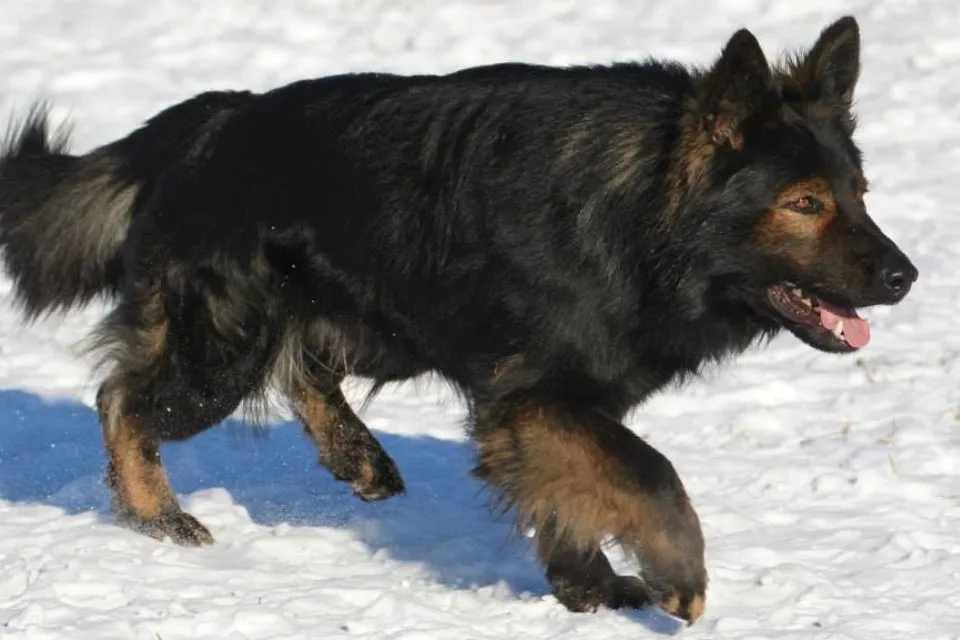
12. Black and Cream Sable (melanistic)
The Black and Cream Sable (melanistic) color variation is a subtle and unique pattern that blends light cream tones with dark, melanistic shading.
The cream serves as the base color, while the dark-tipped hairs create the characteristic “sable” effect, giving the coat depth and dimension. The black shading is more prominent in this variation, softening the contrast for a refined and understated appearance.
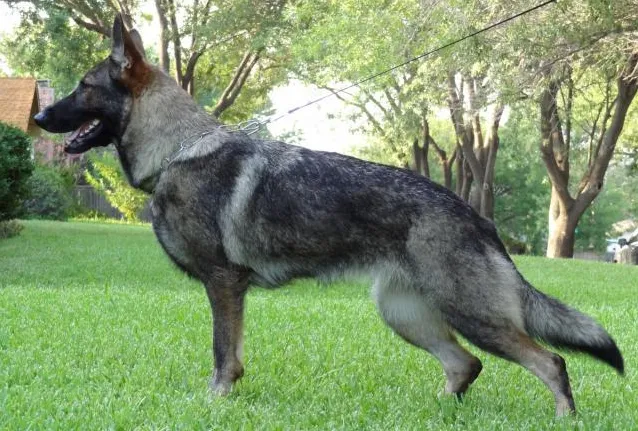
13. Silver Sable (melanistic)
The Silver Sable (melanistic) color variation is a captivating pattern that combines a silver-gray base coat with dark-tipped hairs, creating the signature “sable” effect.
The melanistic shading enhances the black tones, blending seamlessly with the silvery hues for a sleek, wolf-like appearance.
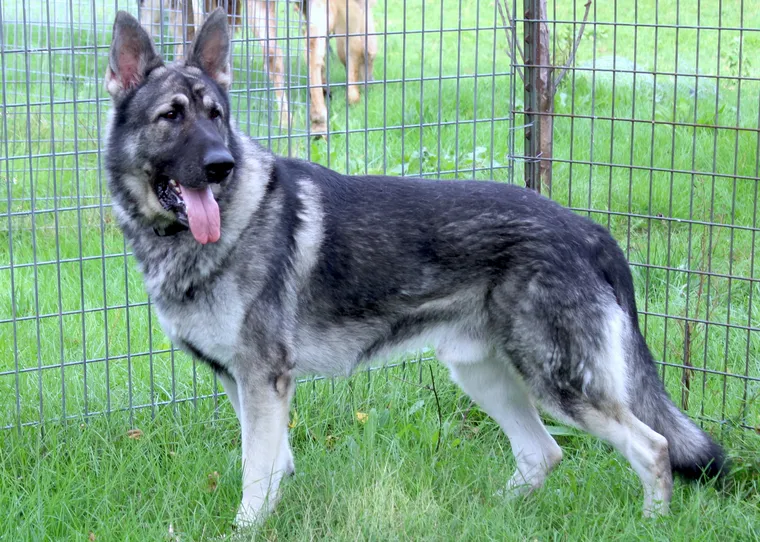
14. Light Silver Sable
The Light Silver Sable color variation is a soft and ethereal coat pattern that features a pale silver or gray base with minimal dark-tipped hairs, creating a subdued “sable” effect.
The lighter tones give the dog a sleek and graceful appearance, often reminiscent of a wolf’s natural coloring.
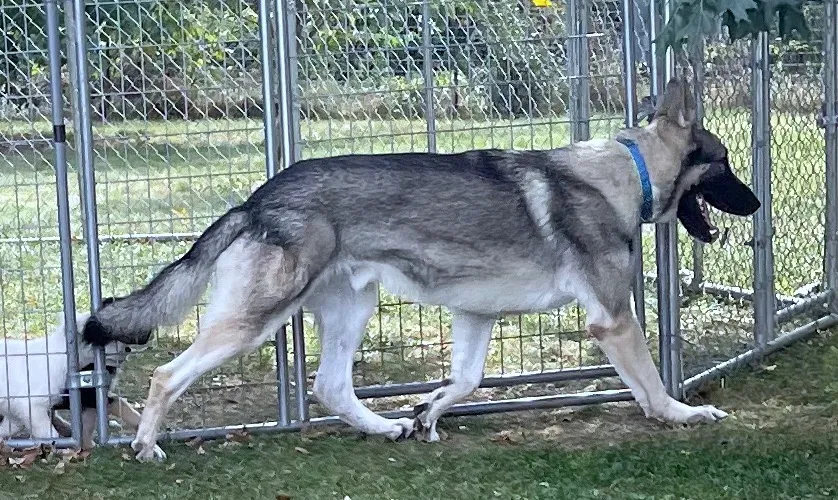
15. Golden Sable Recessive Saddle
The Golden Sable Recessive Saddle color variation features a rich golden or tan base coat, complemented by darker-tipped hairs that create a soft sable effect. This coloration gives the dog a warm, radiant appearance with a natural, sun-kissed look.
The Recessive Saddle pattern is a more subtle version of the traditional saddle, where the black markings on the back are lighter and blend smoothly into the golden coat, offering a more muted and elegant contrast.
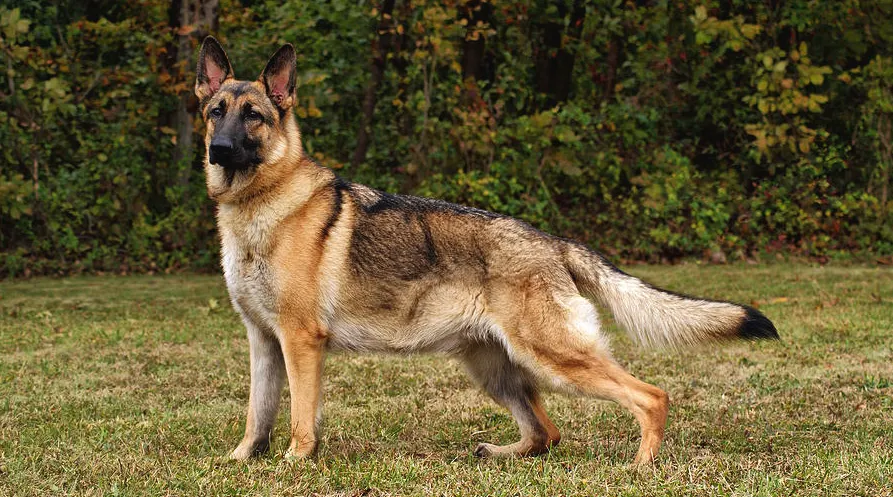
16. Liver and Tan Saddle
The Liver and Tan Saddle Coat Color Variation features a beautiful combination of a rich liver brown base with tan markings, typically on the legs, chest, face, and underbelly, alongside a classic “saddle” pattern on the back.
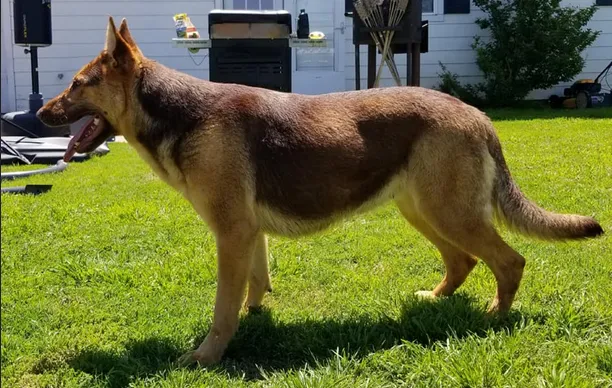
17. Liver Bicolor
The Liver Bicolor Coat Color Variation features a striking combination of a deep liver-brown base coat with minimal tan or lighter markings, typically found on the legs, face, or under the tail.
Unlike standard bicolor German Shepherds, the contrast in this variation is between liver and tan rather than black and tan.
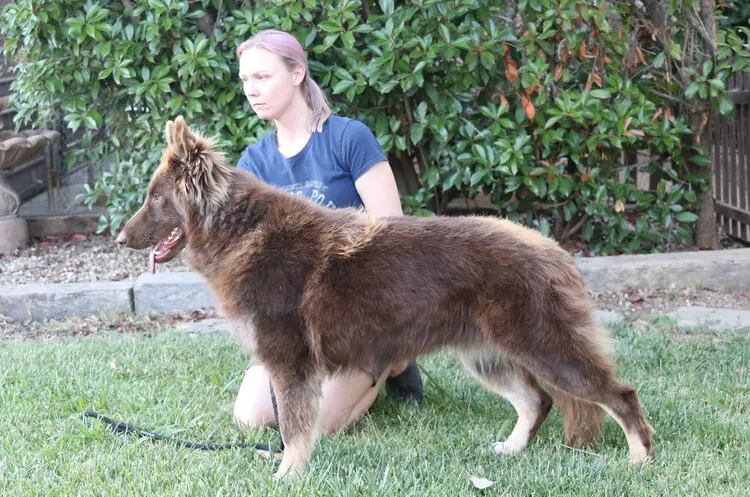
18. Liver Blanket
The Liver Blanket Coat Color Variation is a captivating variation characterized by a rich liver-brown “blanket” covering most of the back and upper body, contrasted with tan or lighter markings on the legs, chest, and face.
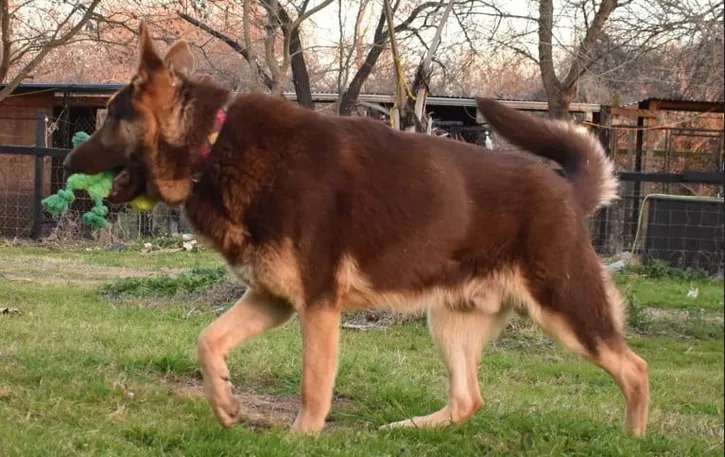
19. Liver Recessive Saddle
The Liver Recessive Coat Color Variation features a stunning blend of a deep reddish base color accented by a liver-brown saddle pattern across the back.
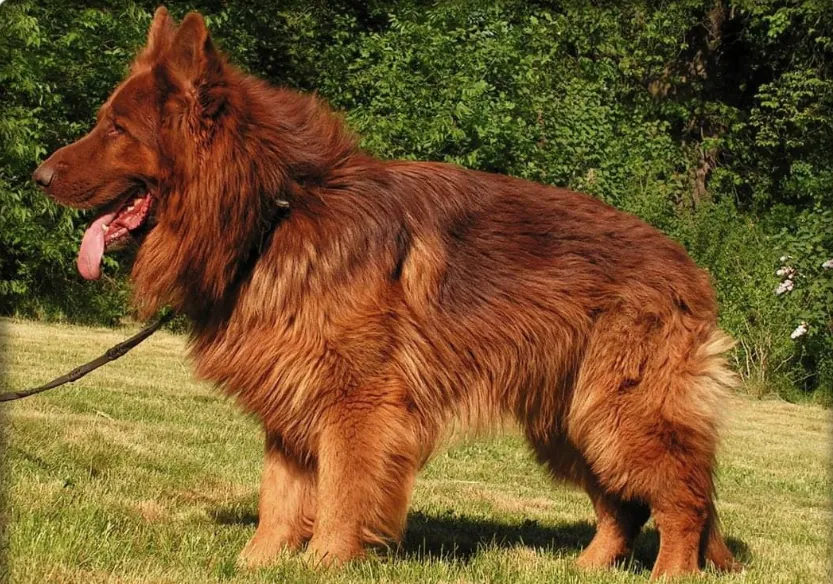
20. Liver Fawn
The Liver Fawn Coat Color Variation features a soft, diluted coat with a light tan or fawn base and subtle liver-brown accents. This rare color combination results from the interaction of the recessive liver gene and other dilution factors, creating a pale, warm-toned appearance.
The nose and paw pads are typically liver-colored, complementing the coat.
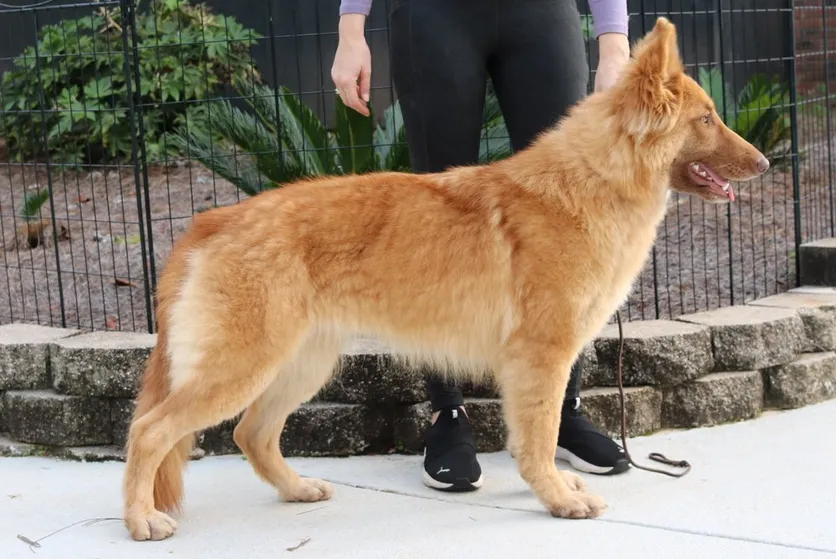
21. Isabella Bicolor & Blanket
The Isabella Coat Color Variation can have both bicolor and blanket coat patterns, though both are relatively rare.
The Isabella Blanket and Bicolor variations are characterized by a light, warm fawn or pale tan base coat with a distinct darker marking across the dog’s back. This darker area, usually dark brown, extends from the shoulders down to the tail, creating a solid, uniform coloration.
The legs retain the softer, diluted Isabella color, giving the dog a striking contrast between the pale and dark sections of its coat. In blanket color variation the darker color covers only half of the back legs, whereas in bicolor color variation, the darker color covers more than half of the both front and back legs.
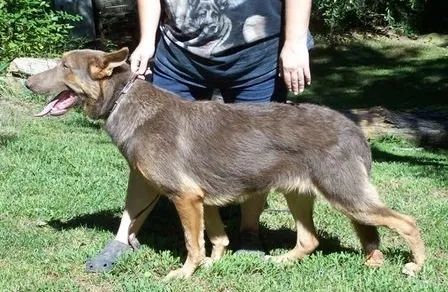
22. Isabella Sable
The Isabella Sable Coat Color Variation is a rare and striking coat variation characterized by a soft, dilute coloration. This unique appearance results from a recessive gene combination that lightens the traditional black-and-tan or black-and-red hues.
The Isabella tone is a blend of light beige, fawn, and silvery-blue shades, often with sable (agouti) markings where individual hairs are banded in different colors.
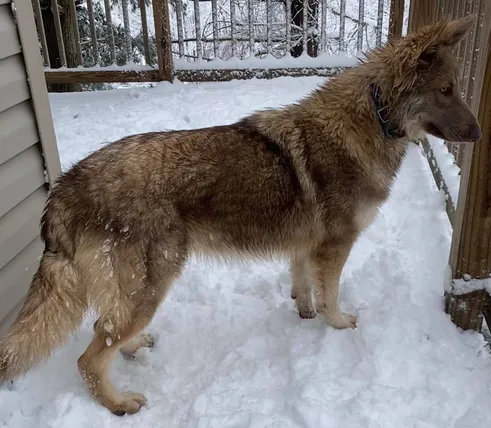
23. Blue Sable
The Blue Sable in German Shepherds is a captivating coat color variation that combines the unique sable pattern with a dilute blue tone. Each hair in the sable pattern features multiple bands of color, typically blending shades of blue-gray, tan, and cream.
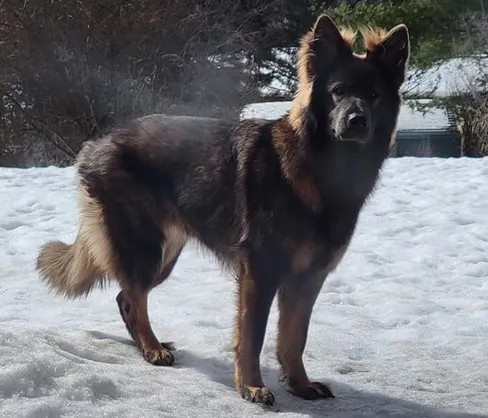
24. Blue Seal
The Blue Seal Coat Color Variation is a rare and eye-catching variation defined by a dark, nearly black appearance with a subtle blue hue.
This variation occurs due to the dilution of black pigment, giving the coat a distinctive “seal” tone that appears dark under most lighting but reveals hints of blue in brighter light.
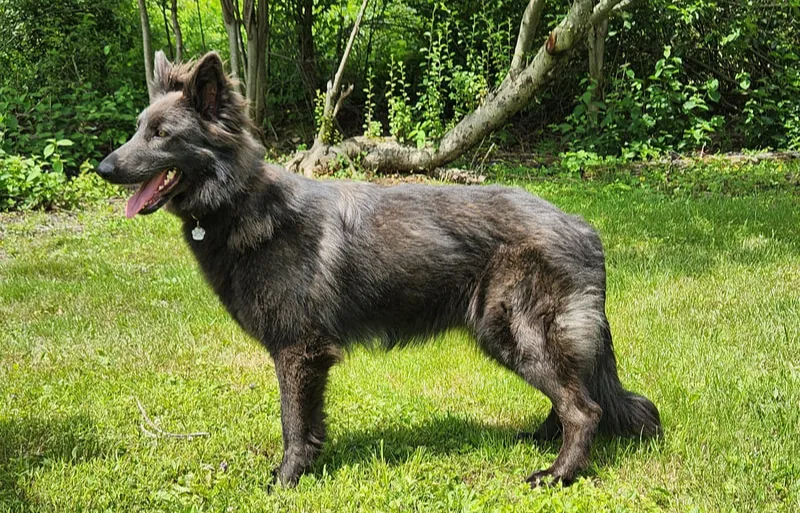
25. Powder Blue and Tan Saddle
The Powder Blue and Tan Saddle is a rare and elegant coat variation featuring a soft, diluted blue tone paired with warm tan markings in the classic saddle pattern. The powder blue hue gives the coat a delicate and pastel-like appearance, creating a striking contrast with the rich tan areas on the legs, chest, and face.
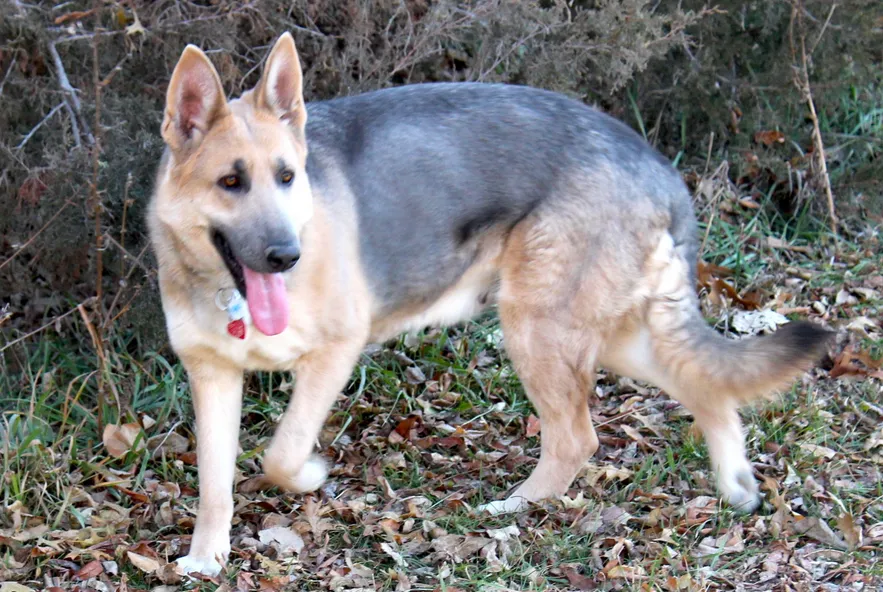
26. Solid Cream Recessive Saddle
The Solid Cream Recessive Saddle is a rare and striking coat variation in German Shepherds. It features a creamy, light-colored base coat with distinct saddle-shaped markings, typically in a slightly darker cream or pale golden hue.
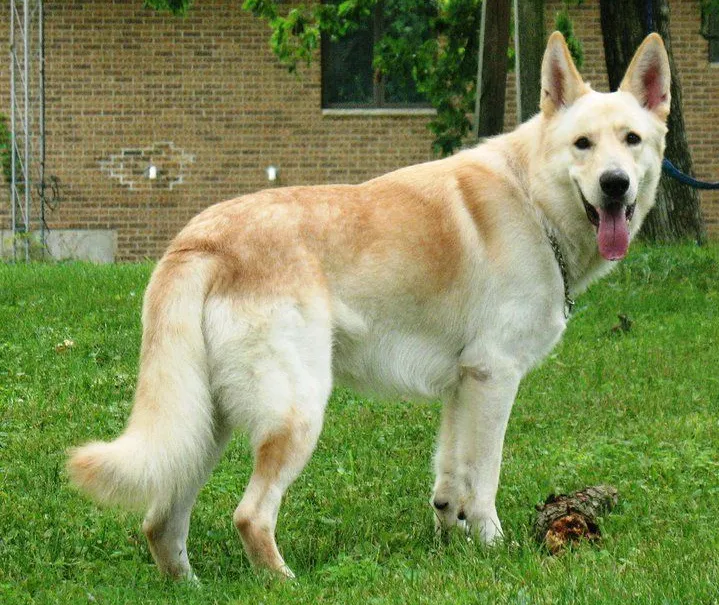
27. Maskless Silver Sable
The Maskless Silver Sable is a unique and striking coat variation in German Shepherds. This pattern features a shimmering silver base coat with classic sable shading that creates a dynamic, wolf-like appearance. Unlike typical sable patterns, the maskless variation lacks the usual dark facial mask, giving the dog a softer, more open expression.
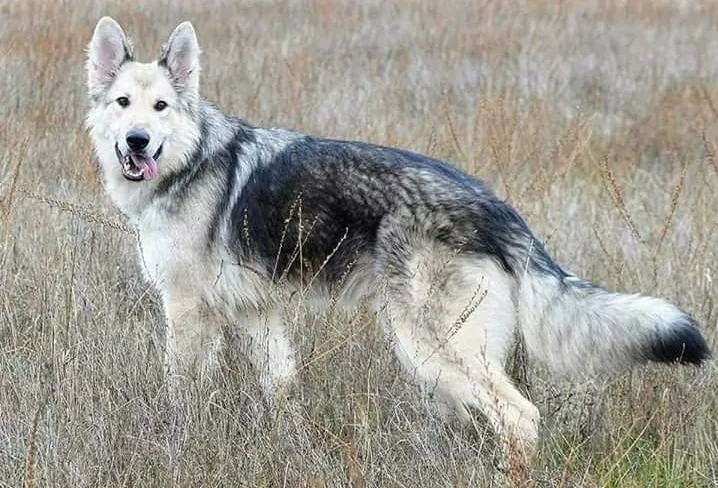
28. Reverse Mask
The Reverse Mask is an intriguing coat variation in German Shepherds. Unlike the typical dark facial mask seen in most German Shepherds, this variation features lighter coloration on the face, often contrasting with darker shades on the body.
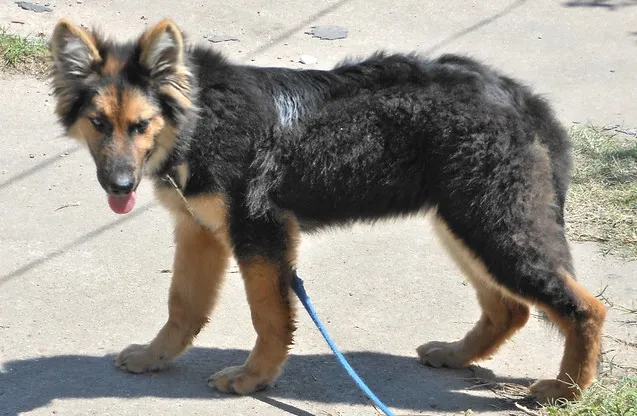
29. Black, White, and Tan Panda
The Black, White, and Tan Panda is a rare, but most common coat variation in Panda German Shepherds. This pattern features a mix of black, white, and tan markings, with white often concentrated on the chest, face, and legs, resembling a “panda-like” appearance.
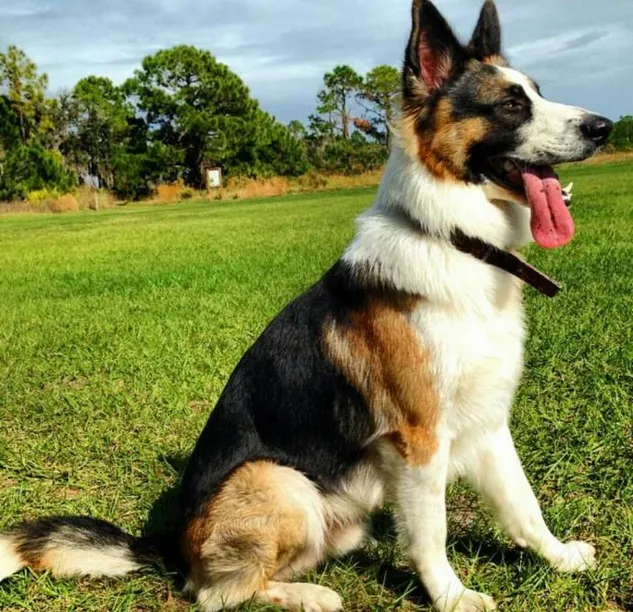
32. Silver Sable Panda
The Silver Sable is a graceful and captivating coat variation in German Shepherds. This pattern features a shimmering silver base coat interwoven with dark sable shading, creating a wolf-like, dynamic appearance. The sable pattern typically includes darker hair tips that give the coat depth and texture.
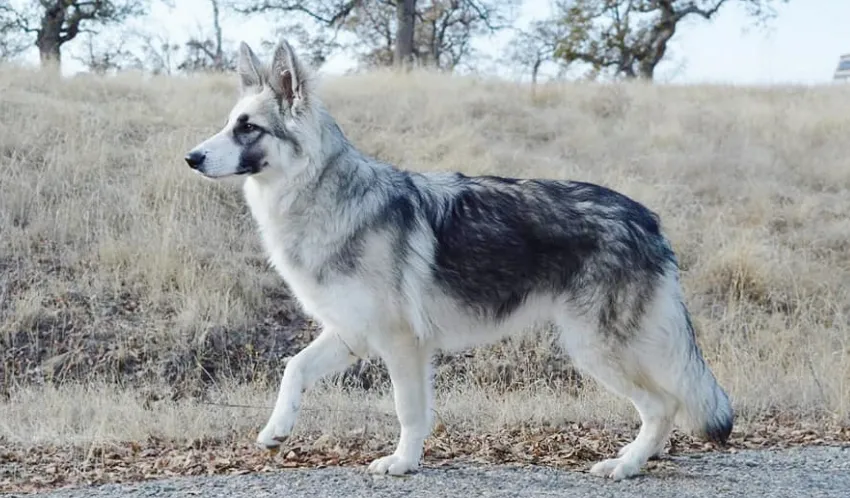
33. Black and White Panda
The Black and White coat variation features a sharp contrast between deep black and crisp white markings, often distributed in unique, eye-catching patterns across the body. The black may dominate the coat with white accents on the chest, legs, and face, or the two colors may be more evenly distributed.
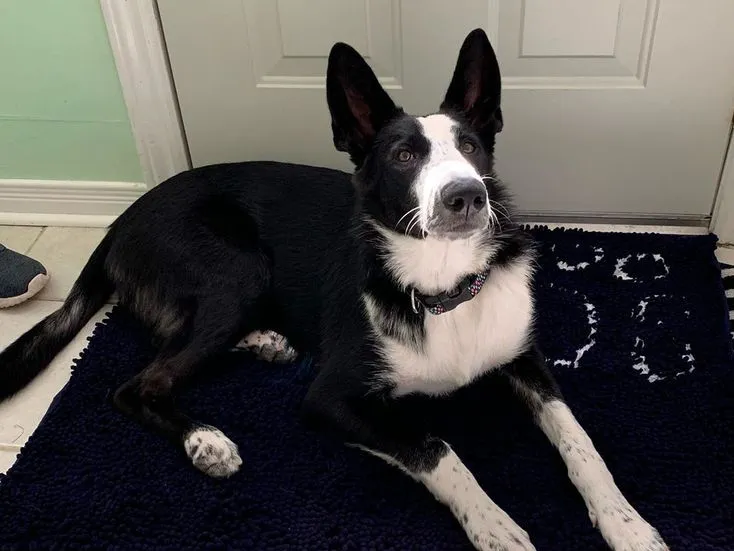
34. Blue and Silver Panda
The Blue and Silver coat variation features a soft blue-gray base coat complemented by shimmering silver accents, creating a sleek and refined appearance.
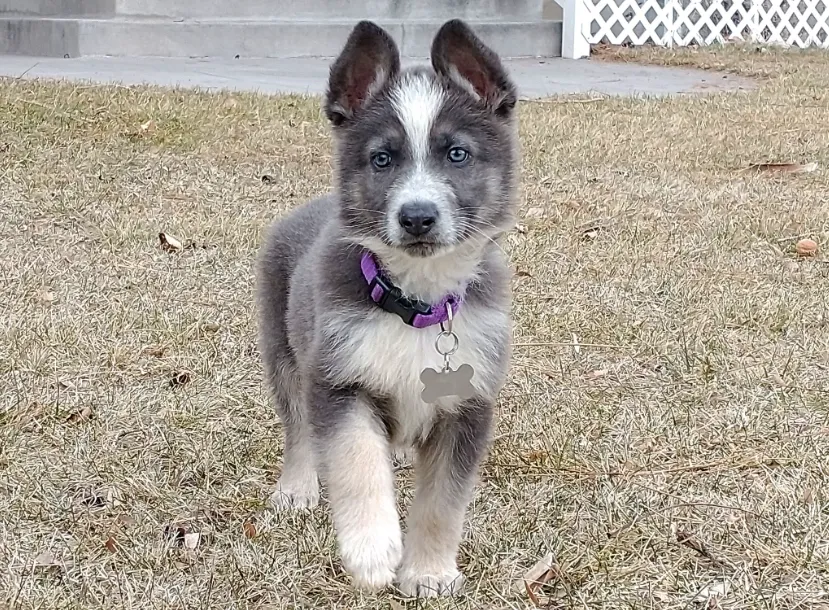
35. Silver and Liver Sable Panda
The Silver and Liver Sable coat variation is a unique coloration that features a soft silver base combined with warm liver-hued sable shading, giving the coat a rich, dynamic appearance.
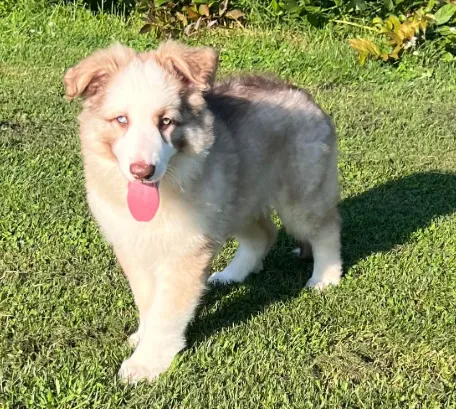
36. Liver and White Panda
The Liver and White panda coat color pattern is a rare and eye-catching variation. These dogs have a predominantly liver-colored coat (a rich reddish-brown shade) accented by white markings, often on the chest, face, and legs, creating a unique panda-like appearance.
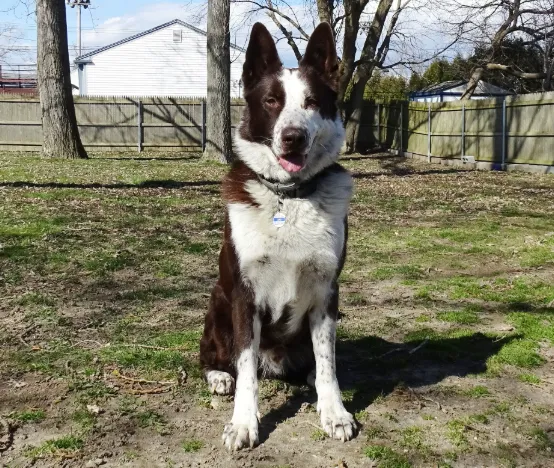
37. Liver, Tan, and White Panda
The Liver, Tan, and White panda coat color pattern is a rare and beautiful variation. These dogs feature a predominantly liver coat with tan points, typically on the legs and face, complemented by striking white markings on areas such as the chest, face, and paws.
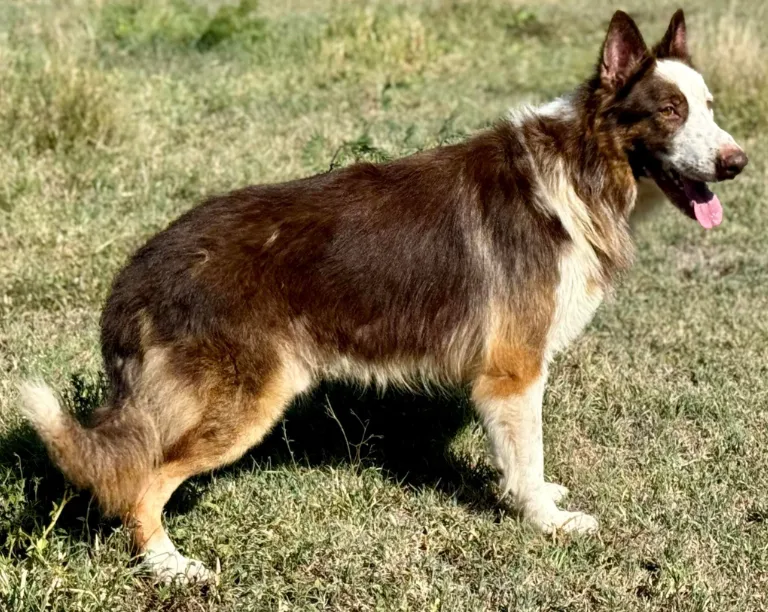
Final Thoughts
German Shepherds are not only celebrated for their intelligence, loyalty, and versatility but also for the diverse range of coat color patterns and variations that make each dog truly unique. From traditional sable and black to rare patterns like panda or liver variations, these colors add to the breed’s charm without affecting their exceptional temperament or working abilities. Whether you’re drawn to the classic or the unusual, every German Shepherd is a stunning example of beauty and functionality combined.
If you like this post then don’t forget to share with others. Share your feedback in the comments section below.
Also Read
- Common Mistakes to Avoid When Grooming a German Shepherd
- Degenerative Myelopathy in German Shepherds | Causes & Prevention
- Common German Shepherd Health Myths Debunked
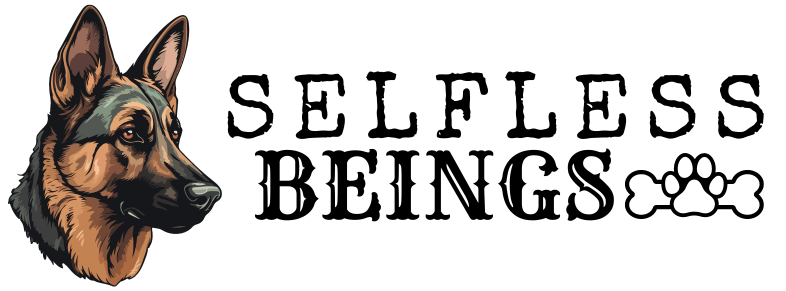
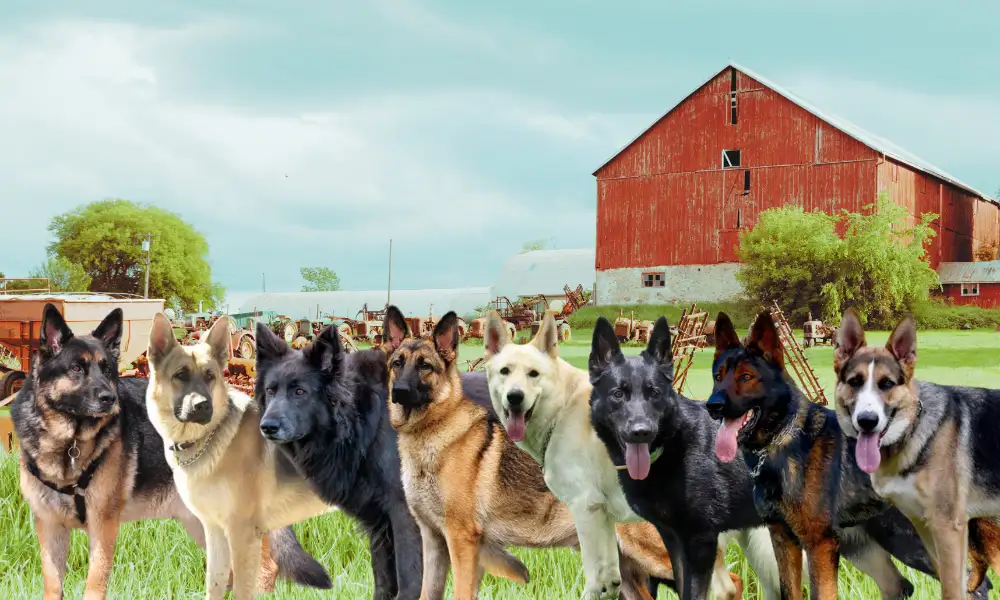


Leave a Reply